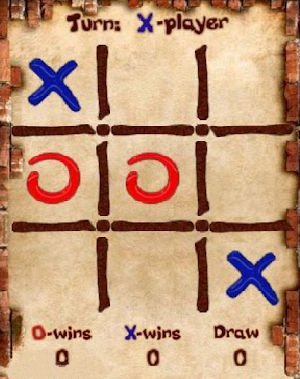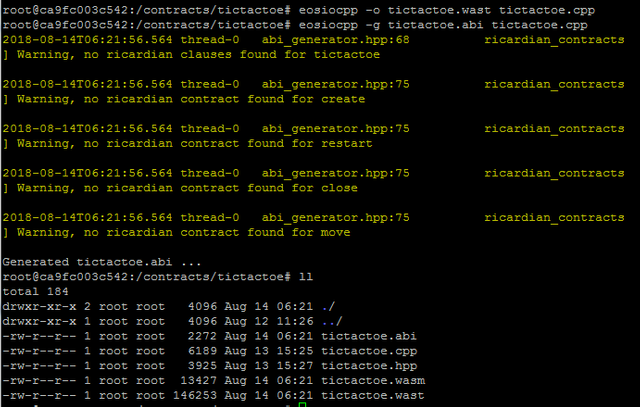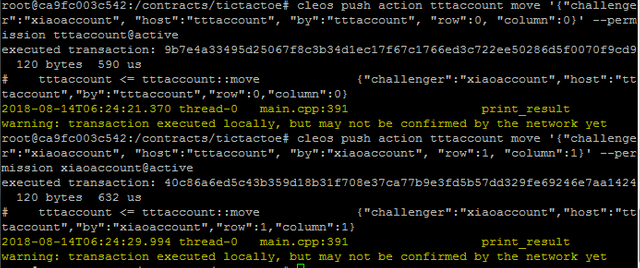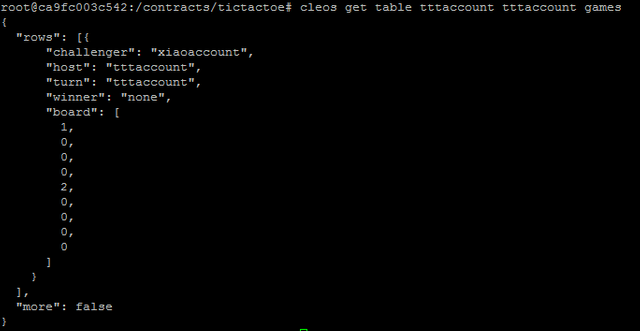手把手教你玩eos:编写智能合约游戏——三连棋
文章由EOS节点EOSWing(柚翼)首发于eoswing.io博客,内容将不定期更新,仅供学习交流之用。

- 引言
0.1 教程概况
手把手教你学eos系列教程,从最基础开始,一步一步教你学会用eos。比如发代币,开发DAPP等等。
本文是第五篇,主要是如何使用eos智能合约编写一个游戏:三连棋。
0.2 学习内容
1.相关准备知识
2.编写智能合约
3.编译和运行智能合约
0.3 机器环境
cpu: 1核
内存: 2G
操作系统:CentOS 7.4 64位
服务器所在地:香港
推荐将服务器放在网络较为优质的环境,比如香港。不然会有很多配置依赖下载上的问题。
提示:以下命令行默认在root权限下执行。如遇权限问题,请在命令前加sudo。
- 相关准备知识
1.1 三连棋游戏规则
三连棋,又称“井字棋”,是棋类的一种,棋盘为九宫格,呈“井”字形,玩家双方各代表○或×,在棋盘上任意一方连成三个(横竖斜均可)就胜利了。

1.2 Multi-Index
Multi-Index是eosio上的数据库管理接口,通过eosio::multi_index智能合约能够写入、读取和修改eosio数据库的数据。
一个完整的multi_index表定义如下:
struct limit_order {
uint64_t id;
uint128_t price;
uint64_t expiration;
account_name owner;
auto primary_key() const { return id; }
uint64_t get_expiration() const { return expiration; }
uint128_t get_price() const { return price; }
EOSLIB_SERIALIZE( limit_order, ( id )( price )( expiration )( owner ) )
};
1.3 建立项目框架
使用eosiocpp建立项目框架:
cd /contracts
eosiocpp -n tictactoe
cd tictactoe
ll
命令行输出如下:

2 编写智能合约
2.1 编写hpp文件
引入标准库,编写基本结构
#include <eosiolib/eosio.hpp>
class tictactoe : public eosio::contract {
public:
tictactoe( account_name self ):contract(self){}
//...游戏数据定义...
//...游戏命令定义...
};
游戏数据定义,参看1.2 Multi-Index。
struct game {
static const uint16_t board_width = 3;
static const uint16_t board_height = 3;
game() {
initialize_board();
}
account_name challenger; //挑战者
account_name host; //主角
account_name turn; // 当前角色 host/challenger
account_name winner = N(none); // none/draw/name of host/name of challenger
std::vector board;
// 初始化棋盘
void initialize_board() {
board = std::vector(board_width * board_height, 0);
}
// 初始化游戏
voidreset_game() {
initialize_board();
turn = host;
winner = N(none);
}
auto primary_key() const { return challenger; }
EOSLIB_SERIALIZE( game, (challenger)(host)(turn)(winner)(board))
};
typedef eosio::multi_index< N(games), game> games;
游戏命令定义
/// @abi action
/// 创建新游戏
void create(const account_name& challenger,const account_name& host);
/// @abi action
/// 重新开始游戏
void restart(const account_name& challenger, const account_name& host,const account_name& by);
/// @abi action
/// 结束游戏
void close(const account_name& challenger,const account_name& host);
/// @abi action
/// 下棋
void move(const account_name& challenger,const account_name& host,const account_name& by,const uint16_t& row,const uint16_t& column);
hpp的完整源文件可以查看官方的github代码库:
https://github.com/EOSIO/eos/blob/master/contracts/tic_tac_toe/tic_tac_toe.hpp
本教程为避免代码文件冲突,仅修改tic_tac_toe为tictactoe
2.2 编写cpp文件
编写基本结构
#include "tictactoe.hpp"
using namespace eosio;
创建新游戏:
void tictactoe::create(const account_name& challenger, const account_name& host) {
//验证主角签名
require_auth(host);
//验证主角和挑战者不是同一人
eosio_assert(challenger != host, "challenger shouldn't be the same as host");
//验证主角和挑战者当前没有游戏
games existing_host_games(_self, host);
auto itr = existing_host_games.find( challenger );
eosio_assert(itr == existing_host_games.end(), "game already exists");
//初始化游戏
existing_host_games.emplace(host, [&]( auto& g ) {
g.challenger = challenger;
g.host = host;
g.turn = host;
});
}
重新开始游戏:
void tictactoe::restart(const account_name& challenger, const account_name& host, const account_name& by) {
//验证请求者签名
require_auth(by);
//验证这场游戏是否存在
games existing_host_games(_self, host);
auto itr = existing_host_games.find( challenger );
eosio_assert(itr != existing_host_games.end(), "game doesn't exists");
//验证请求者是不是主角或者挑战者
eosio_assert(by == itr->host || by == itr->challenger, "this is not your game!");
//重新开始游戏
existing_host_games.modify(itr, itr->host, []( auto& g ) {
g.reset_game();
});
}
结束游戏:
void tictactoe::close(const account_name& challenger, const account_name& host) {
//验证主角签名
require_auth(host);
//验证这场游戏是否存在
games existing_host_games(_self, host);
auto itr = existing_host_games.find( challenger );
eosio_assert(itr != existing_host_games.end(), "game doesn't exists");
//删除游戏
existing_host_games.erase(itr);
}
下棋:
void tictactoe::move(const account_name& challenger, const account_name& host, const account_name& by, const uint16_t& row, const uint16_t& column ) {
//验证请求者签名
require_auth(by);
//验证这场游戏是否存在
games existing_host_games(_self, host);
auto itr = existing_host_games.find( challenger );
eosio_assert(itr != existing_host_games.end(), "game doesn't exists");
//验证游戏没有结束
eosio_assert(itr->winner == N(none), "the game has ended!");
//验证请求者是不是主角或者挑战者
eosio_assert(by == itr->host || by == itr->challenger, "this is not your game!");
//验证是不是轮到请求者下棋
eosio_assert(by == itr->turn, "it's not your turn yet!");
//验证这一步棋子是不是下在空的棋盘格子
//is_valid_movement方法提取出来,在后面单独写
eosio_assert(is_valid_movement(row, column, itr->board), "not a valid movement!");
//记录这一步下棋数据
const uint8_t cell_value = itr->turn == itr->host ? 1 : 2;
const auto turn = itr->turn == itr->host ? itr->challenger : itr->host;
existing_host_games.modify(itr, itr->host, [&]( auto& g ) {
g.board[row * tictactoe::game::board_width + column] = cell_value;
g.turn = turn;
//验证这一步棋,是不是赢了比赛
//赢家验证get_winner方法提取出来,在后面单独写
g.winner = get_winner(g);
});
}
下棋步数有效验证方法is_valid_movement
bool is_empty_cell (const uint8_t& cell) {
return cell == 0;
}
bool is_valid_movement (const uint16_t& row, const uint16_t& column, const vector<uint8_t>& board) {
uint32_t movement_location = row * tictactoe::game::board_width + column;
bool is_valid = movement_location < board.size() && is_empty_cell(board[movement_location]);
return is_valid;
}
赢家验证
游戏规则:在横向、纵向和对角线任意一个方向上连线三点就赢得比赛。
account_name get_winner (const tictactoe::game& current_game) {
auto& board = current_game.board;
bool is_board_full = true;
//采用&操作符来计算横向、纵向和对角线上的连线值。
//3 == 0b11, 2 == 0b10, 1 = 0b01, 0 = 0b00
vector consecutive_column(tictactoe::game::board_width, 3 );
vector consecutive_row(tictactoe::game::board_height, 3 );
uint32_t consecutive_diagonal_backslash = 3;
uint32_t consecutive_diagonal_slash = 3;
for (uint32_t i = 0; i < board.size(); i++) {
is_board_full &= is_empty_cell(board[i]);
uint16_t row = uint16_t(i / tictactoe::game::board_width);
uint16_t column = uint16_t(i % tictactoe::game::board_width);
//计算横向和纵向的连线值
consecutive_row[column] = consecutive_row[column] & board[i];
consecutive_column[row] = consecutive_column[row] & board[i];
//计算对角线的连线值
if (row == column) {
consecutive_diagonal_backslash = consecutive_diagonal_backslash & board[i];
}
if ( row + column == tictactoe::game::board_width - 1) {
consecutive_diagonal_slash = consecutive_diagonal_slash & board[i];
}
}
//检查所有横向、纵向和对角线的连线值并决定赢家
vector aggregate = { consecutive_diagonal_backslash, consecutive_diagonal_slash };
aggregate.insert(aggregate.end(), consecutive_column.begin(), consecutive_column.end());
aggregate.insert(aggregate.end(), consecutive_row.begin(), consecutive_row.end());
for (auto value: aggregate) {
if (value == 1) {
return current_game.host;
} else if (value == 2) {
return current_game.challenger;
}
}
// 检查是否已有赢家,有就返回
return is_board_full ? N(draw) : N(none);
}
cpp的完整源文件可以查看官方的github代码库:
https://github.com/EOSIO/eos/blob/master/contracts/tic_tac_toe/tic_tac_toe.cpp
本教程为避免代码文件冲突,仅修改tic_tac_toe为tictactoe
3 编译和运行智能合约
3.1 编译合约
eosiocpp -o tictactoe.wast tictactoe.cpp
eosiocpp -g tictactoe.abi tictactoe.cpp
ll
命令行输出如下:

3.2 创建合约账户tttaccount
解锁xiao钱包,创建公钥-私钥对,导入公钥-私钥对到钱包,最后,用公钥创建tttaccount。
具体步骤不再赘述,不熟悉的可以翻看以前的教程。
tttaccount创建后命令行输出如下:

3.3 上传合同到账户
cleos set contract tttaccount /contracts/tictactoe -p tttaccount@active
命令行输出如下:

3.4 运行智能合约
创建游戏
cleos push action tttaccount create '{"challenger":"xiaoaccount", "host":"tttaccount"}' -p tttaccount@active
命令行输出如下:

下棋
cleos push action tttaccount move '{"challenger":"xiaoaccount", "host":"tttaccount", "by":"tttaccount", "row":0, "column":0}' --permission tttaccount@active
cleos push action tttaccount move '{"challenger":"xiaoaccount", "host":"tttaccount", "by":"xiaoaccount", "row":1, "column":1}' --permission xiaoaccount@active
命令行输出如下:

查看游戏状态数据:
cleos get table tttaccount tttaccount games
命令行输出如下:

重新开始游戏
cleos push action tttaccount restart '{"challenger":"xiaoaccount", "host":"tttaccount", "by":"tttaccount"}' --permission tttaccount@active
命令行输出如下:

结束游戏
cleos push action tttaccount close '{"challenger":"xiaoaccount", "host":"tttaccount"}' --permission tttaccount@active
命令行输出如下:

4 后记
延伸阅读
在本文的学习中如果遇到问题,欢迎留言或者在如下链接寻找解决方案:
三连棋教程: https://developers.eos.io/eosio-cpp/docs/tic-tac-toe-tutorial
如果觉得这一系列教程有点意思,请投票给柚翼节点(eoswingdotio)。您的投票是本教程持续更新的动力源泉,谢谢。